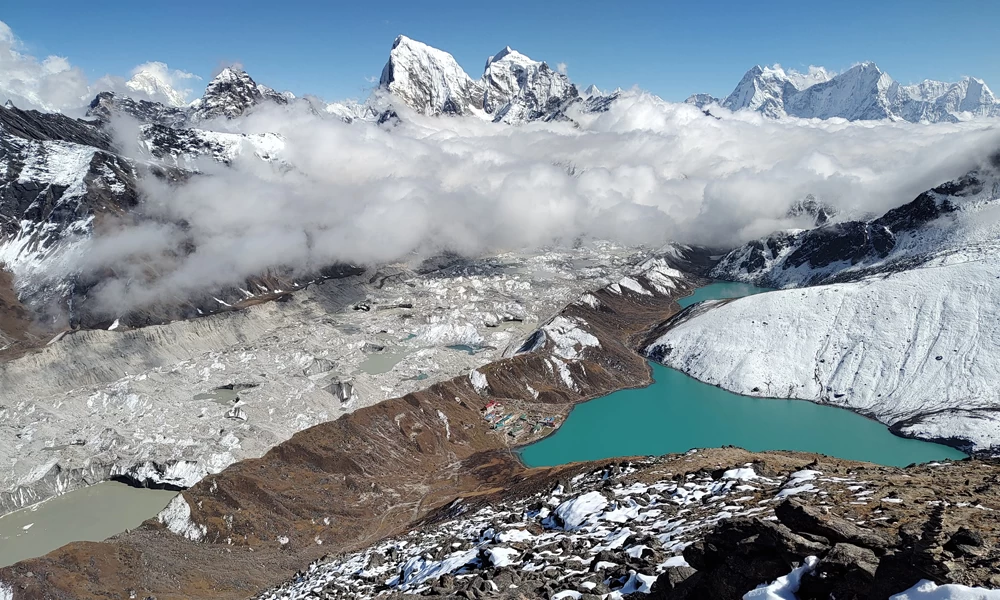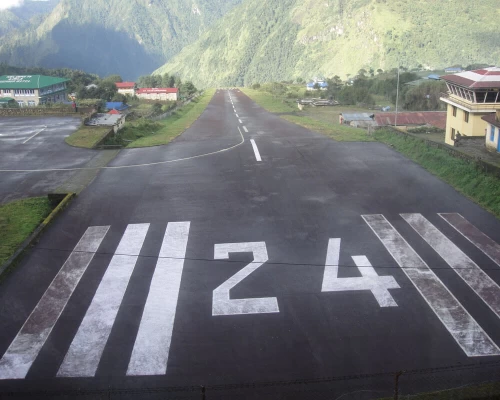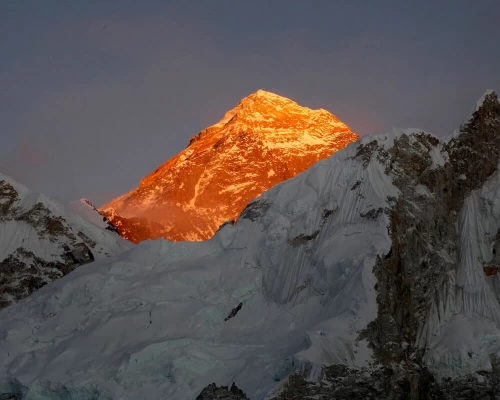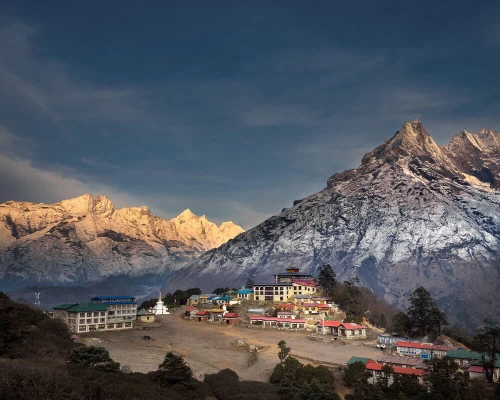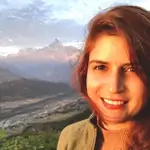Lifetime Adventure: Everest Base Camp Trek 15 Days. Travel with us for an indelible journey. You will surely love the company of our guides native to the Khumbu Region.
Let us make your Dream Come True!!!
The 15 days Everest Base Camp Trek, also known as the EBC trek, is an exciting high-altitude adventure in the Solukhumbu region of Nepal that takes you to the base of the world's most towering peak, Mount Everest (8848.86 m). Everest Base Camp Trek is a dream come true for adventure enthusiasts. It is a fantastic adventure for each, allowing one to steer some of the world's most well-known trekking trails. Ever since Mt. Everest was first represented on a world map in 1856, the trip to the mountain base camp has become a prominent tourist attraction. This incredible opportunity provides trekkers with an immersive environment and a thrilling experience. The trek offers an immersive experience amidst the Himalayan scenery, beautiful rivers, charming villages, dense rhododendron forests, numerous rope bridges, and breathtaking views of Mt. Everest (8,848.86 meters), Mt. Lhotse (8,516 meters), Mt. Makalu (8,481 meters), and Cho Oyu (8,188 meters).
The journey begins in Lukla with an adventurous flight to the gateway of Everest. The journey continues, taking trekkers through thick forests, traditional Sherpa settlements, and serene green woodlands. The trekking trails are adorned with colorful prayer wheels and flags, and they cross several suspension bridges and ancient monasteries. The trek also provides a possibility to interact with the Sherpa community, known for their rich Buddhist traditions and customs, and get a chance to know and experience their lifestyle and the challenges they face in this high-altitude region. A notable highlight is the Tengboche Monastery, a spiritual sanctuary along the way.
Everest Base Camp is the starting point for climbers attempting to summit the world's highest peak. It's located in the Khumbu region of Nepal, within the Sagarmatha National Park, a UNESCO World Heritage Site that preserves Himalayan flora and fauna.
If you want to see Everest but aren’t ready to trek, consider the Everest Base Camp Helicopter Tour. It is a quick way to experience the grandeur of the Himalayas without the physical effort of trekking.
A Typical Day on the 15 Days - Everest Base Camp Trek
A typical day on the Everest Base Camp trek starts early, often around 6:30 AM. Your morning starts with a warm cup of tea or coffee served by your teahouse. After a hearty breakfast, you pack your gear and hit the trail by 7:30 or 8:00 AM. The morning trek involves traversing rugged trails, crossing suspension bridges, and ascending gradual inclines while soaking in the majestic views of snow-capped peaks.
You will stop for a mid-morning break to rest and hydrate before continuing to the next village for lunch. Lunch time is usually at around noon. After refueling with a meal, the trek resumes, often with steeper climbs or descents, depending on the day’s destination.
By mid-afternoon, you will arrive at the next teahouse, where you can relax. You can enjoy a hot drink and explore the surroundings if your energy permits. Evenings are cozy and communal, with dinner served in a warm dining area. You can share stories, and we will also plan for the next day. By around 8:00 PM, most people head to their rooms for a good night’s sleep, preparing for another adventurous day ahead.
Outline Itinerary for 15-day Everest Base Camp Trek
Day | Activity | Distance | Duration | Altitude |
01 | Arrival in Kathmandu | - | - | 1,400 m (Kathmandu) |
02 | Fly to Lukla, trek to Phakding | 8 km | 4 hours | 2,652 m (Phakding) |
03 | Trek from Phakding to Namche Bazaar | 11-12 km | 6 hours | 3,440 m (Namche Bazaar) |
04 | Acclimatization day in Namche Bazaar | 4-5 km | 4 hours | 3,440 m (Namche Bazaar) |
05 | Trek from Namche to Tengboche | 11 km | 5-6 hours | 3,860 m (Tengboche) |
06 | Trek from Tengboche to Dingboche | 12 km | 6 hours | 4,410 m (Dingboche) |
07 | Acclimatization day in Dingboche | 6 km | 5 hours | 5,083 m (Nangkartshang Peak) |
08 | Trek from Dingboche to Lobuche | 11 km | 5 hours | 4,910m (Lobuche) |
09 | Trek to Gorak Shep, hike to Everest Base Camp, return to Gorak Shep | 14 km | 8 hours | 5,364 m (Everest Base Camp) |
10 | Hike to Kala Patthar, trek back to Pheriche | 14 km | 7 hours | 5,545 m (Kala Patthar) |
11 | Trek to Tengboche | 12 km | 5 hours | 3,867 m (Tengboche) |
12 | Trek to Namche Bazaar | 10 km | 5 hours | 3,440 m (Namche Bazaar) |
13 | Trek from Namche to Lukla | 18 km | 7 hours | 2,860 m (Lukla) |
14 | Fly back to Kathmandu | - | - | 1,400 m (Kathmandu) |
15 | Departure Transfer | - | - | - |
Permits for Everest Base Camp Trek
To trek to Everest Base Camp, you will need the SNP Entry Permit and Municipality Permit:
Sagarmatha National Park Entry Permit
This permit is required for entering the Sagarmatha National Park, where most of the trek takes place.
Cost:
NPR 3,000 per person (approximately USD 25) for foreigners.
NPR 1,500 per person for SAARC nationals.
NPR 100 for Nepali citizens.
Where to Obtain:
You can apply for the permit at the Nepal Tourism Board office in Kathmandu.
Khumbu Pasang Lhamu Rural Municipality Permit (Local Permit)
Introduced in 2020, this local government permit is mandatory for trekking in the Khumbu region.
Cost:
NPR 2,000 per person (approximately USD 15) for all trekkers.
Where to Obtain:
The rural municipality counter is at Lukla or Monjo.
Is a 15-day Everest Base Camp Trek Suitable for You?
Deciding whether the 15-day Everest Base Camp trek is suitable for you depends on several factors, including your physical fitness, trekking experience, and expectations.
The trek involves long daily walks, often 5–7 hours, across rugged and steep trails at high altitudes. A good level of physical fitness is essential. If you regularly engage in endurance activities like hiking, running, or cycling, you are likely well-prepared.
The trek takes you to an elevation of 5,364 meters (17,598 feet) at Everest Base Camp and 5,545 meters (18,192 feet) at Kala Patthar. Acclimatization days are built into the itinerary, but you should be aware of the risks of altitude sickness and be prepared to listen to your body.
While prior trekking experience is not mandatory, it can be advantageous. If this is your first multi-day trek, consider training with shorter treks beforehand to familiarize yourself with the demands of such an adventure.
Trekking to EBC is as much a mental challenge as a physical one. Days can be long, the weather unpredictable, and the conditions basic. Staying positive and adaptable is key to enjoying the experience.
The EBC trek is one of the most cost-effective ways to experience the Himalayas, but it still requires budgeting for permits, flights, gear, guides, and teahouse accommodations. Additionally, you will need 15 days of availability, including contingency for potential delays.
The trek is suitable for solo trekkers, but going with a group or guide can enhance your experience by ensuring safety, companionship, and a deeper cultural understanding.
Who Is It Best Suited For?
Trekkers seeking an adventurous, bucket-list journey.
Nature lovers who want to experience the Himalayas up close.
Those who are prepared for physical and mental challenges at high altitudes.
If you are relatively fit, eager for adventure, and excited to experience Nepal’s breathtaking landscapes and Sherpa culture, this trek is an excellent choice for you.
How to prepare for the Everest Base Camp 15 Days Trekking?
Preparing for the 15-day Everest Base Camp (EBC) trek involves physical, mental, and logistical preparation to ensure a safe and enjoyable adventure. Here’s a step-by-step guide to help you get ready:
Physical Fitness Training
Building strength, stamina, and endurance is crucial for trekking to EBC.
Cardio Workouts: Engage in running, cycling, swimming, or brisk walking 3–5 times a week to improve your cardiovascular fitness.
Hiking Practice: Train with hikes on rugged terrains, gradually increasing the distance and elevation gain. Carry a backpack to simulate trekking conditions.
Strength Training: Focus on leg muscles, core, and back through exercises like squats, lunges, and planks.
Flexibility: Incorporate yoga or stretching exercises to prevent injuries.
Acclimatization Readiness
High altitudes can cause altitude sickness, so:
Spend time acclimatizing during the trek (built into the itinerary).
Practice hiking at higher altitudes before your trip if possible.
Stay hydrated, avoid alcohol, and take it slow during the trek.
Gear and Equipment
Invest in good-quality trekking gear to stay comfortable and safe.
Clothing: Pack layers, including moisture-wicking base layers, insulating mid-layers, and waterproof outer layers.
Footwear: Use well-broken-in hiking boots and bring comfortable trekking socks.
Backpack: A 40-45L daypack is ideal for carrying essentials.
Accessories: Trekking poles, gloves, hats, sunglasses, and a headlamp are essential.
Health and Safety
Medical Check-Up: Consult your doctor to ensure you’re fit for high-altitude trekking.
Vaccinations: Check if you need any vaccinations for Nepal.
Travel Insurance: Get insurance that covers trekking at high altitudes and emergency evacuation.
First Aid Kit: Include basic medications, bandages, blister care items, and altitude sickness tablets like Diamox.
Mental Preparedness
The trek is challenging but immensely rewarding. Prepare yourself mentally for:
Long trekking days (5–7 hours daily).
Basic facilities and accommodations.
Unpredictable weather conditions.
Diet and Nutrition
Stay hydrated and avoid alcohol or smoking before and during the trek.
Eat a balanced diet rich in carbohydrates and proteins to build energy reserves.

